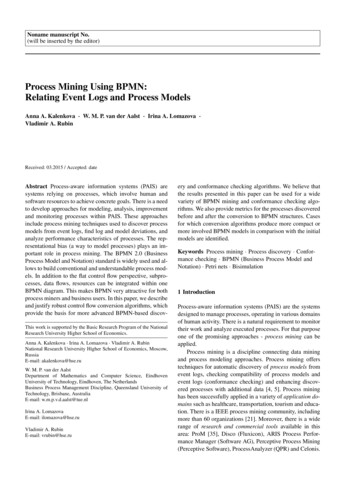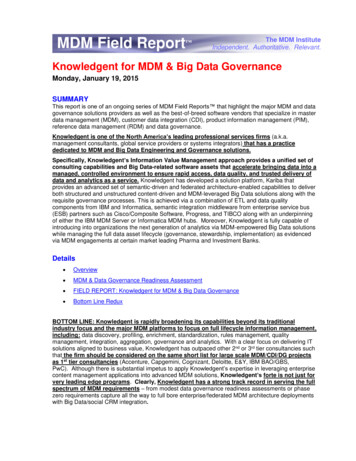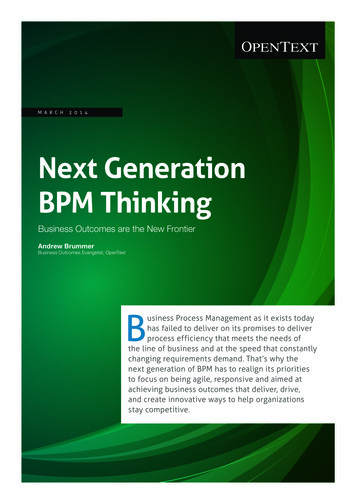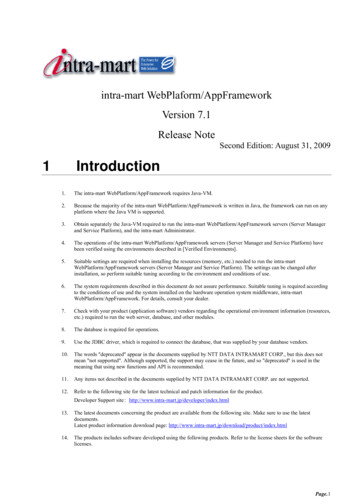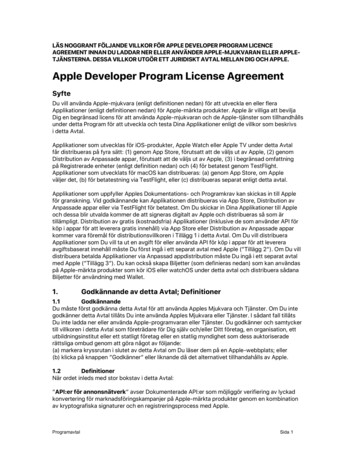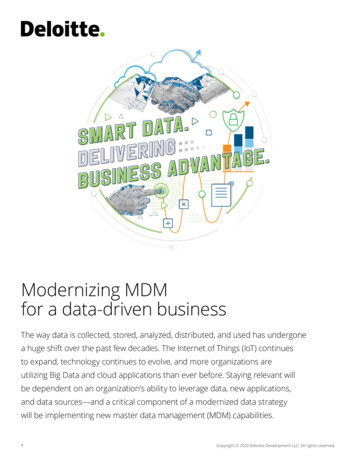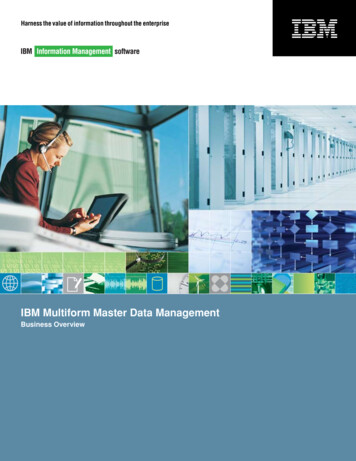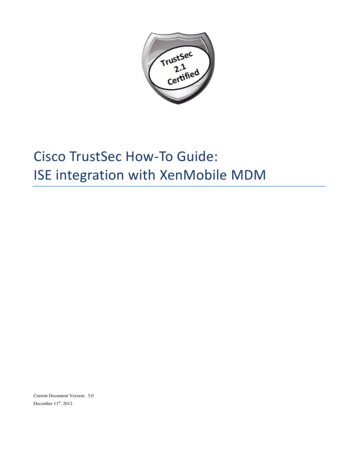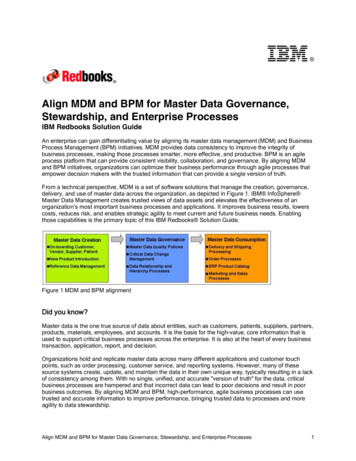
Transcription
Align MDM and BPM for Master Data Governance,Stewardship, and Enterprise ProcessesIBM Redbooks Solution GuideAn enterprise can gain differentiating value by aligning its master data management (MDM) and BusinessProcess Management (BPM) initiatives. MDM provides data consistency to improve the integrity ofbusiness processes, making those processes smarter, more effective, and productive. BPM is an agileprocess platform that can provide consistent visibility, collaboration, and governance. By aligning MDMand BPM initiatives, organizations can optimize their business performance through agile processes thatempower decision makers with the trusted information that can provide a single version of truth.From a technical perspective, MDM is a set of software solutions that manage the creation, governance,delivery, and use of master data across the organization, as depicted in Figure 1. IBM InfoSphere Master Data Management creates trusted views of data assets and elevates the effectiveness of anorganization’s most important business processes and applications. It improves business results, lowerscosts, reduces risk, and enables strategic agility to meet current and future business needs. Enablingthose capabilities is the primary topic of this IBM Redbooks Solution Guide.Figure 1 MDM and BPM alignmentDid you know?Master data is the one true source of data about entities, such as customers, patients, suppliers, partners,products, materials, employees, and accounts. It is the basis for the high-value, core information that isused to support critical business processes across the enterprise. It is also at the heart of every businesstransaction, application, report, and decision.Organizations hold and replicate master data across many different applications and customer touchpoints, such as order processing, customer service, and reporting systems. However, many of thesesource systems create, update, and maintain the data in their own unique way, typically resulting in a lackof consistency among them. With no single, unified, and accurate "version of truth" for the data, criticalbusiness processes are hampered and that incorrect data can lead to poor decisions and result in poorbusiness outcomes. By aligning MDM and BPM, high-performance, agile business processes can usetrusted and accurate information to improve performance, bringing trusted data to processes and moreagility to data stewardship.Align MDM and BPM for Master Data Governance, Stewardship, and Enterprise Processes1
Business valueOrganizations are looking to transform their businesses. One way is by creating a synergistic value withMDM and BPM. To fully realize that goal, they must bring their MDM and BPM projects closer together.Aligning the priorities, goals, requirements, milestones, and stakeholders of these often separate teamsaffords significant benefit to each team, and the organization and its employees benefit. A combined MDMand BPM solution brings more value to business processes. As a result, enterprises are looking for waysto connect all of these processes in a managed technology solution. The IBM InfoSphere MDM productportfolio provides a way to apply governance to enterprise master data by using IBM InfoSphere MDMsolutions.Many companies have deployed MDM strategies to resolve the problem of inconsistent data. MDM is adiscipline that provides a single, unified, and trusted view of master data entities for any user orapplication. From a technical perspective, MDM is a set of software solutions that manage the creation,governance, delivery, and use of master data across the organization. MDM connects all the informationthat was gathered about a particular entity or event from all the enterprise systems to form a morecomplete view of that entity or event to enable an understanding of its true value. MDM also providesmechanisms and governance for consistent use of master data across the organization. As a result, MDMenables better business processes.BPM methodologies, supported by a Business Process Management System (BPMS), allow for the rapidcreation of value-centric process solutions with a dramatically reduced time to return on investment (ROI).When implemented, these processes are more easily modified to adapt to change, whether as a result ofmarket conditions, regulations, or strategic shifts in corporate goals. By abstracting the business processlogic and rules from traditional applications and services layers into business processes, the reuse andefficiency of IT resources increase. Business key performance indicators (KPIs) and data governancemetrics, intrinsically provided by process solutions that are implemented by a BPMS, prove theeffectiveness of process improvements, allowing businesses to better prioritize their IT Initiatives.Many of the benefits of BPM are realized during an enterprise’s first process implementation, such as anIBM led Quick Win Pilot (QWP). QWP is a 12-week services offering that achieves only a limitedproduction release. It often creates a chain reaction of process-oriented adjustments that allowbusinesses to achieve dramatic improvements. Often, only the degree to which senior business andtechnical leaders can transform their IT and business operation dictates how these process successescan be scaled into BPM programs that support and drive corporate initiatives. Such initiatives includeimproved product quality, reduced time-to-market, expanded markets, increased customer satisfaction,and improved profit margins.Solution overviewIBM InfoSphere Master Data Management creates trusted views of data assets and elevates theeffectiveness of an organization’s most important business processes and applications. It improvesbusiness results, lowers costs, reduces risk, and enables strategic agility to meet current and futurebusiness needs.The IBM InfoSphere Master Data Management platform provides the assurance that enterprise masterdata is accurate, valid, relevant, and timely, and it can be trusted. InfoSphere MDM provides trust throughits own data governance and stewardship processes for continuous enforcement of data quality, ensuringthat business process requirements are satisfied. MDM and BPM are a mix of technology andmethodology that enable organizations to improve process performance through better management andgovernance.Align MDM and BPM for Master Data Governance, Stewardship, and Enterprise Processes2
Regardless of how good the quality of the information is that a business maintains, the desired businessgoals cannot be realized if the main business processes have the following characteristics: Are inefficientDo not meet client needsAre difficult to adapt to meet new business challengesBy aligning MDM and BPM, high-performance, agile business processes can use trusted and accurateinformation to improve performance, bringing trusted data to processes and more agility to datastewardship. For the key business drivers and value propositions to align MDM and BPM projects, see thewhite paper, "Transforming business processes by aligning BPM and MDM," at this lias?infotype SA&subtype WH&htmlfid WSW14176USENA combined MDM and BPM solution brings the following benefits: Provides ways to work together to improve the business processesEnables the capability to apply governance to enterprise master dataEnsures that complete, accurate, and trustworthy information is available to the business processesThe points at which MDM and BPM intersect are called patterns. MDM and BPM have the followingpatterns: Master data creationAfter an organization identifies its master data, the organization must aggregate it to link and resolveduplicates and to ensure that processes are not creating duplicates. The master data creationprocess calls for master data to be added to the MDM hub. In this pattern, customer on-boarding,account creation, vendor on-boarding, and other typical business processes push the master datathat they author into MDM and search MDM to update existing master data. Probabilistic,deterministic, and other automated entity consolidation techniques are applied to resolve the masterdata into the single accurate version of the truth. Master data consumptionMaster data is created for use within business processes. Business process decisions that useaccurate data are more productive and efficient. Consider the following example where a businessprocess does not use accurate data. John’s business recently moved. When he places an order withthe call center representative (Billy), John is not found by his address or his home phone number. Thecustomer relationship management (CRM) system creates an unwanted duplicate account.John expects this purchase to promote him to a higher class of service that includes free shipping.John is confused when he sees that his invoice has a shipping charge. He calls back to customerservice where, after some investigation, Sue finds two accounts for John with the same cell phonenumber. Sue attempts to resolve the issue: updating the contact information for the original accountand deactivating the duplicate account. Sue must manually upgrade John’s class of service, and hisrecent purchase history is orphaned from this account.Every process uses data. Whether data comes from various enterprise systems or one application, itmust be accurate and trusted before it can be used. Whether human or automated, decisions are onlyas good as the information available at the time they are made. MDM ensures that accurate, trustedmaster data is available to the process decisions that need it.Align MDM and BPM for Master Data Governance, Stewardship, and Enterprise Processes3
Master data governanceCreating master data and using it within business processes are the two primary points where MDMand BPM intersect within a business. In some scenarios, newly created master data must haveadditional assurances applied before business users can have confidence in the master data. Thisconfidence can be required for consumption within their business processes, as illustrated in Figure 2.Figure 2 MDM and BPM intersectionsMaster data governance provides business owners assurances that master data is a trusted assetthat is ready for use within their business processes. Consuming processes have requirements withwhich master data must comply. These consumption-centric master data requirements can includeattribute validation requirements that are associated with the completeness of a record, specificattribute values, and code table validation. Master data governance provides the capabilities that arenecessary to administer and monitor these requirements as policies. Using a master data governanceprocess to enforce these policies provides the assurances to business owners that master data is notonly accurate but also supports their usage requirements. BPM Express, the program that supportsMDM, is the platform for implementing this process-oriented data stewardship.Figure 3 shows the master data governance process to enforce these policies. This process includespolicy administration, policy monitoring, and policy enforcement.Align MDM and BPM for Master Data Governance, Stewardship, and Enterprise Processes4
Figure 3 Master data governance process to enforce policiesWith the capabilities provided by IBM InfoSphere Master Data Management (MDM), organizations caneasily add master data to their enterprise processes, such as customer on-boarding. These processesensure that decision makers have the accurate, single version of truth for making informed decisions.These same capabilities bring process-oriented data stewardship to the organization, providingassurances that master data complies with enterprise process requirements.Solution architectureIBM provides a number of tools with each component in the solution architecture.IBM Business Process ManagerThe following tools are provided to facilitate rapid construction of the business process across anorganization: IBM BPM Process DesignerIBM Process Designer provides a rich environment so that process designers can develop, test,deploy, and version business processes across their organization. Process Designer also provides anadvanced extension framework so that custom components can be easily plugged in to further extendthe base capabilities. IBM Process PortalIBM Process Portal for IBM Business Process Manager is a runtime platform for deployed businessprocesses. By using Process Portal, a user can authenticate with their credentials and use a runtimeenvironment to run process steps that are assigned to the user. Process Portal provides web-basedcapabilities so that users can see all outstanding tasks that are assigned to them in one place. Theweb-based capabilities also give users the ability to start any new processes that they are authorizedto launch. Graphical-based reporting capabilities are provided so that a user can monitor individualand team performance for a particular time.Align MDM and BPM for Master Data Governance, Stewardship, and Enterprise Processes5
Java IntegratorThis node is a Java class to be provided by an integration developer that defines the operations thatmust be started on the consuming systems. The Java integration node can then be configured to runa method within the class to run a transaction against the consuming system. Web Services IntegratorThis node provides a simple way to integrate a business process with services that are provided byother systems that use a service-oriented architecture (SOA). For example, it allows a Web ServicesDescription Language (WSDL) from a consuming system to be uploaded to BPM Process Designer.MDM Integration approachesThe following tools are provided to facilitate rapid construction of business process across anorganization: MDM Web ServicesThe InfoSphere Master Data Management platform provides several web services interfaces so thatexternal systems, such as the MDM virtual eSOA interface and the MDM physical web services, canact on MDM data. Virtual MDM Java InterfaceThe InfoSphere MDM platform provides includes a Java application programming interface (API) forinteracting with the virtual MDM data model. This API works against the physical representation of thedata within the virtual data model.MDM Application Toolkit capabilitiesThis toolkit provides a suite of value-add capabilities to facilitate construction of process-orientedMDM-powered applications. The MDM Application Toolkit takes advantage of the extensible nature ofProcess Designer to provide more capabilities to organizations that build MDM applications within IBMBusiness Process Manager. The MDM Application Toolkit includes the following features: Pre-built business objects that represent commonly described MDM business objects Business objects that represent generic virtual MDM data types for use against the virtual MDM Javainterface Additional UI controls Several pre-built integration services to perform common operations against MDM dataUsage scenariosIn this scenario, we put a focus on master data governance and stewardship as a critical part of enterprisesolutions. We think master data governance and stewardship are requirements for defining andmaintaining the data derived from the integration of Master Data Management and Business ProcessManagement. That is, you not only need to access and use trusted data and use proven businesspractices, but you must maintain the data over time and integrate it with your other enterprise solutions.Align MDM and BPM for Master Data Governance, Stewardship, and Enterprise Processes6
Here, we define master data governance for multidomain master data management (MDM) with severaldata governance aspects and policy control types. Master data refers to data that is foundational tobusiness processes and is widely distributed. The distributed data, when well managed, directlycontributes to the success of an organization, and when not well managed, poses the most risk. Inaddition, we describe the roles of the data governance processes and key performance indicators (KPIs)and their critical importance for achieving mature levels of data governance.It is commonly recognized that business information is one of the most important assets of any modernenterprise, and is typically built into enterprise policies. However, these policies often cannot be actedupon because there is no commonly accepted standard for measuring and reporting on the corporateinformation assets. A lack of information asset KPIs makes it difficult to establish data governanceorganizations. In addition, it is also difficult to assign individuals who are accountable for the quantity andquality of enterprise information assets overall. These assets might greatly contribute to the equity of thecorporations and market capitalization, but it is often difficult to set meaningful quantitative targets forcorporate information assets, their growth, and improvement.Master data typically includes a few major master information domains, such as party/customer, product,location, service, account, employee, and supplier, and it includes the relationships between thosedomains. In addition, master data includes reference data that serves as qualifiers for the masterinformation domains, such as account types, customer categories, industry codes, and geographicalareas. The reference data justifies a priority treatment of master data, which requires both technology andbusiness strategy.In many enterprises, master data has been a major strategy and implementation focus area for the lastfew years, and the effort requires support from business. Insufficient business directions can adverselyaffect the outcomes of the MDM initiative. By the nature of master data, its broad distribution, andmultifunctional use, no single business function can take exclusive responsibility for master datarequirements, rules, and processes. In some cases, requirements from different functional areas caneven conflict with each other in terms of their content and priorities. This situation substantiates the needfor a cross-functional master data governance council. The MDM market recognizes that data governanceis critical for enterprise MDM implementations. Master data governance is a discipline that concentrateson controls, methodologies, capabilities, and tools that have been developed by modern MDM over thelast decade.Master data governance has the following objectives: Establish a master data governance council or board. Formulate master data governance policies that establish accountability and enforcement. Monitor, oversee, and enforce proactive, collaborative, and effective data stewardship that is drivenby data governance. Acquire and use tools that enable master data governance and data governance-driven stewardship,including policy administration, enforcement, remediation, and monitoring.IBM offers a comprehensive set of products and components for master data management andgovernance.Figure 4 illustrates the IBM multidimensional approach to master data governance.Align MDM and BPM for Master Data Governance, Stewardship, and Enterprise Processes7
Figure 4 Multidimensional approach to MDMAs illustrated in Figure 4, policy management is addressed by policy administration, enforcement, andmonitoring components. All aspects of master data governance are addressed. The governance aspectsinclude data quality and stewardship for master data, data visibility, privacy, and security (especiallycritical for customer data), and business and technical metadata. The master data governance council is across-functional leadership team. This team works to approve and establish policies that dictate howmaster data is captured, managed, propagated, and used across the enterprise to achieve short-term andlong-term goals. The pursuit of master data governance is an ongoing effort, rather than a one-timeproject.Data stewards are responsible for everyday operations that enforce the guidance and policies of themaster data governance council. Policy enforcement in mature data governance can require complexdata stewardship remediation processes to adequately support business and master data governancerequirements with agile and flexible data flows. Traditionally built applications might be unable to providethe required level of agility and flexibility in the administration of master data governance policies and theirremediation. This requirement puts forward the need to use Business Process Management (BPM)software and templates that are integrated with MDM.Master data governance is part of an information governance or data governance discipline. The primaryfocus is on master data implementations where modern MDM patterns are used with MDM data hubtechnologies. If an enterprise establishes a data governance council, a section of this council thatspecializes on MDM can play a role on the master data governance council. Conversely, if a datagovernance council is not established in the enterprise, master data governance can become a seed andstarting point for an enterprise data governance council. Most information governance and datagovernance methodologies lack a master data focus and do not reflect the specifics of modern MDM hubimplementations. Few organizations achieve high master data governance levels of maturity. Thepercentage is even lower than for data governance in general.Master data qualityMaster data quality relies on the following components to effectively manage master data, policies,processes, metrics, and KPIs.Align MDM and BPM for Master Data Governance, Stewardship, and Enterprise Processes8
PoliciesOne goal of master data governance is to enable a master data governance council to define and issuemaster data quality policies. Policies or sets of business rules quantify the policy compliance criteria anddefine how certain levels of data quality can be achieved. Hard policies prevent a record from being savedif a policy is not met and prevent more flexible soft policies. By using soft policies, you can save recordseven if a record does not comply with data governance policies. The noncompliant records are routed to adata stewardship in-box for resolution. In IBM InfoSphere Master Data Management V10.1, policyadministration and policy enforcement are implemented within IBM Business Process Manager Express.Policy monitoring is implemented in the Master Data Policy Dashboard. IBM Cognos is used to report onthe data quality metrics and their compliance with established policy targets.ProcessesAlso known as procedures, workflow, or practices, master data quality processes define how policies areto be implemented. Usually, processes refer to the role or job function that is responsible for taking anaction. They might also specify certain systems, screens, or forms that users in those roles must read,follow, or complete. The processes also address how exceptions are managed, which is typically bystarting a separate process.Processes might specify certain time constraints for a process. For example, they might state that certainactions must be accomplished within a number of hours, minutes, or seconds. Processes might alsospecify escalation paths for higher-level approvals by people in other roles. The processes might startother processes. Therefore, use care to ensure that the processes and procedures are clearly articulated,leave little, if any, room for misinterpretation, and are as complete as possible.Processes are also meant to be living specifications. That is, as experience is gained by practitioners, assystems and regulatory guidelines change, and as other factors come into play, policies and proceduresmight change.Metrics and KPIsData governance is a control discipline. A master data governance council initiates its control throughmaster data quality policies. Metrics are necessary to the degree that the master data governance councilwants to monitor and measure the levels of quality and consistency that are being achieved, inaccordance with policies. For example, a policy states that a goal of completeness or uniqueness must beachieved, or the number of overlays must be reduced. Then, the metrics are the measurements that aretaken so that managers can monitor trends in achieving the goals of the policies.The policies that are defined by the master data governance council must be clearly defined. Mature datagovernance processes require quantitatively managed goals, advanced statistical metrics, andtechniques. Quantitative process improvement objectives must be firmly established and continuouslyrevised to manage process improvement. Advanced scoring algorithms are developed and used toquantify the similarity of records for matching. Scoring above a certain threshold indicates that the tworecords belong to the same customer. This approach has been successfully used in probabilisticmatching. The same scoring APIs can be used to quantify the completeness of the entity records. Themetric that is obtained by scoring a record on itself is referred to as self-score completeness.Go to the IBM Redbooks site (http://www.redbooks.ibm.com/) and download Redbooks publication,Aligning MDM and BPM for Master Data Governance, Stewardship, and Enterprise Processes,SG24-8059, for more detailed information about aligning MDM and BPM to enable trusted and accurateinformation to be used by business processes to optimize business performance and increase agility fordata stewardship. It also provides beginning guidance on these patterns and where cross-training effortsmight focus.Align MDM and BPM for Master Data Governance, Stewardship, and Enterprise Processes9
IntegrationWith the capabilities provided by IBM InfoSphere Master Data Management (MDM), organizations canadd master data to their enterprise processes (such as customer on-boarding). These processes ensurethat decision makers have the accurate, single version of truth for making informed decisions. Thesesame capabilities bring process-oriented data stewardship to the organization, providing assurances thatmaster data complies with enterprise process requirements.Business processes inevitably need to interact with other systems across the enterprise. Whether thesystem is a customer relationship manager (CRM), enterprise resource planning (ERP), or MDM system,data must be retrieved from these systems and decisions must be made on the data as part of a businessprocess. A business process definition defines the various steps of this process, such as when and how auser is required to interact with the process. It also defines the points in the process that are required tomake calls into other systems to get data. How the business process integrates with the other systemslargely depends on the requirements of the business process and the integration options that are providedby the other systems.Figure 5 illustrates the role of a business process definition in defining the interactions between abusiness user and the remote systems that store the data for action as part of the business process.Figure 5 Defining interactionsIBM Business Process Manager provides a rich set of pre-built integration components that facilitateinteracting with other systems across an enterprise, for example: Java IntegratorWeb Services IntegratorWhen you consider a business process that involves operations against a master data hub, determiningwhich integration approach to choose depends on Web Services Integrator and Java Integrator.InfoSphere Master Data Management provides rich interfaces that allow integration by using WebServices Integrator or Java Integrator components. Therefore, the choice can depend on the uniquerequirements of your business process and the environment in which it operates.Align MDM and BPM for Master Data Governance, Stewardship, and Enterprise Processes10
MDM Application ToolkitThe IBM InfoSphere Master Data Management platform includes the MDM Application Toolkit. This toolkitprovides a suite of value-add capabilities to facilitate the construction of process-oriented MDM-poweredapplications. The MDM Application Toolkit takes advantage of the extensible nature of Process Designerto provide more capabilities to organizations that build MDM applications within IBM Business ProcessManager.The MDM Application Toolkit includes the following features: Pre-built business objects that represent commonly described MDM business objects Business objects that represent the generic virtual MDM data types for use against the virtual MDMJava interface Additional UI controls Several pre-built integration services to perform common operations against MDM dataAny combination of these capabilities can be used with the base capabilities that are provided by ProcessDesigner to accelerate the construction of business processes.Supported platformsFor more information, see the Systems Requirements for InfoSphere Master Data Management Server atthis /en/infosphere-master-data-management/Ordering informationThis product is only available via IBM Passport Advantage . It is not available as shrink-wrap. Theseproducts may only be sold directly by IBM or by authorized IBM Business Partners for Software ValuePlus.For more information about IBM Software Value Plus, visit this website:http://www.ibm.com/partnerworld/page/svp authorized portfolioAlign MDM and BPM for Master Data Governance, Stewardship, and Enterprise Processes11
Related information Aligning MDM and BPM for Master Data Governance, Stewardship, and Enterprise 248059.html?OpenInfoSphere Information Server Deployment Architectures, SG24-8028: l?Open "Creating a BPM Center of Excellence (COE)," dp4898.html?OpenScaling BPM Adoption
Align MDM and BPM for Master Data Governance, Stewardship, and Enterprise Processes 5 Figure 3 Master data governance process to enforce policies With the capabilities provided by IBM InfoSphere Master Data Management (MDM), organizations can easily add master data to their enterprise processes, such as customer on-boarding. These processes
